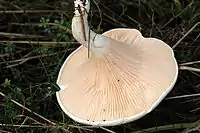Decurrent
Decurrent (sometimes decurring) is a term used in botany and mycology to describe plant or fungal parts that extend downward.
| Look up decurrent in Wiktionary, the free dictionary. |

In botany, the term is most often applied to leaf blades that partly wrap or have wings around the stem or petiole and extend down along the stem. A "decurrent branching habit" is a plant form common for shrubs and most angiosperm trees, contrasted with the excurrent or "cone-shaped crown" common among many gymnosperms.[1] The decurrent habit is characterized by having weak apical dominance that eventually produces a rounded or spreading tree crown. Examples of trees with decurrent habit are most hardwood trees: oak, hickory, maple, etc.[2]
In mycology, the term is most often applied to the hymenophore of a basidiocarp (such as the lamellae or "gills" of a mushroom or the "pores" of a bracket fungus) when it is broadly attached to and extends down the stipe.[3]
References
- Harris RW. (April 1980). "Structural Development of Trees". Journal of Arboriculture. International Society of Arboriculture. 6 (4): 105–107.
- Claud L. Brown, Robert G. McAlpine, Paul P. Kormanik, "Apical Dominance and Form in Woody Plants: A Reappraisal", American Journal of Botany, Vol. 54, No. 2 (February 1967), pp. 153–162, doi:10.2307/2440793
- Ammirati J, Trudell S. (2009). Mushrooms of the Pacific Northwest: Timber Press Field Guide (Timber Press Field Guides). Portland, Oregon: Timber Press. p. 316. ISBN 0-88192-935-2.